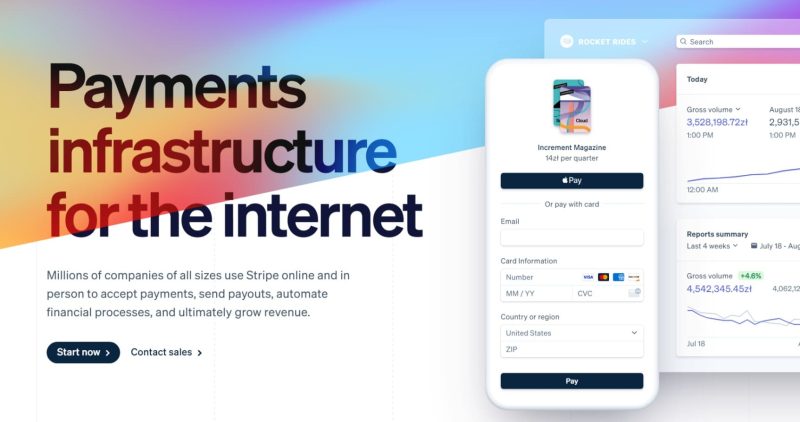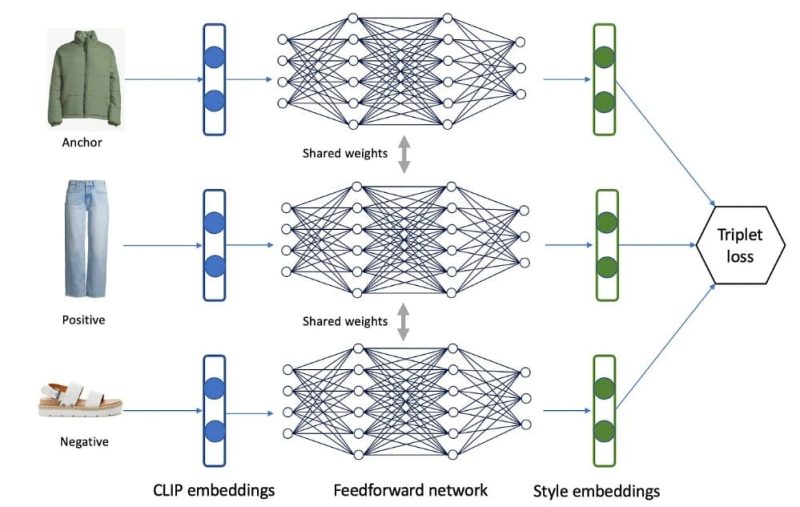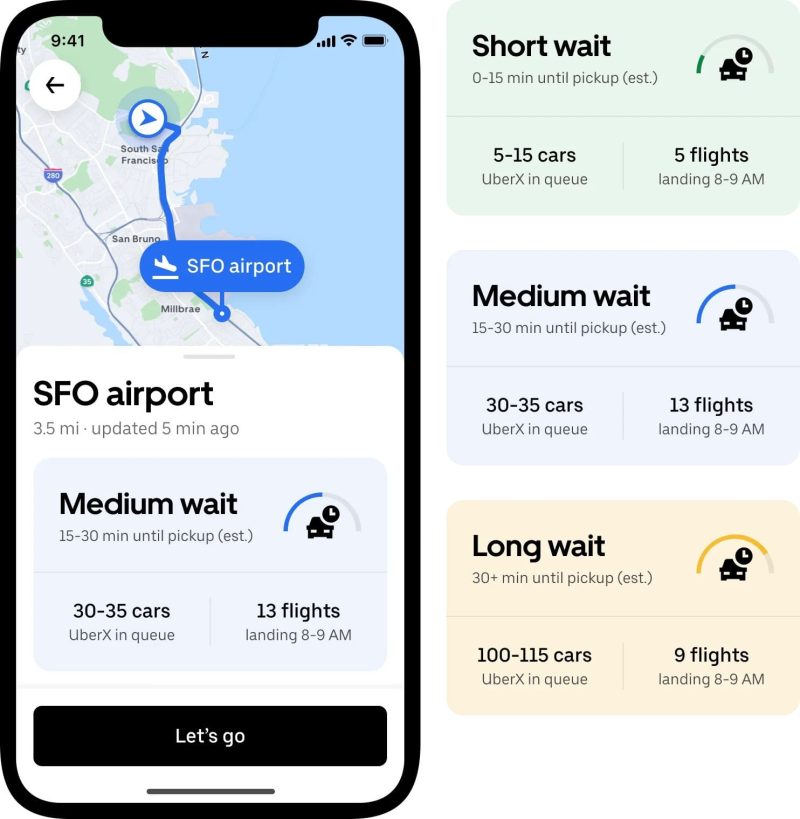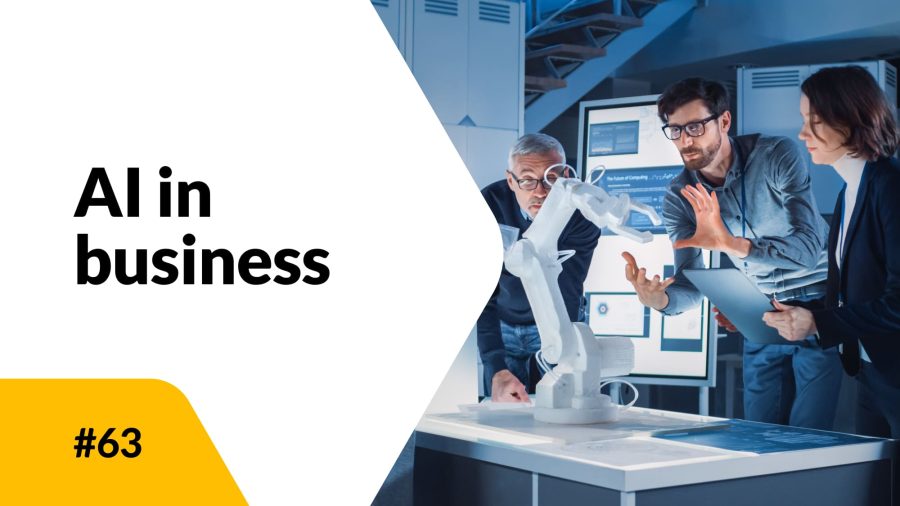AI implementations – table of contents:
- AI implementations in Stripe
- “Complete the Look”, or the AI implementation from Walmart
- Uber - ETR Forecasting
- AI implementations in Pinterest
- Stitch Fix, or headlines and product descriptions generated by AI
- Swiggy
- AI implementations in FoodPanda, or the race for menu optimization
- Zillow
- GitHub Copilot with AI implementations
- AI implementations - summary
In this article, we’ll take a closer look at some interesting AI implementations in businesses. From Stripe’s use of machine learning to detect fraud, to Swiggy’s personalized order experiences, to GitHub Copilot providing real-time support for developers. These examples showcase how artificial intelligence is fueling the creation of innovative services, transforming customer experiences, increasing conversion rates, and streamlining internal processes for businesses and institutions. Read on.
AI implementations in Stripe
Stripe (https://stripe.com/) is an advanced payment platform that enables businesses and institutions to process transactions both online and in traditional retail settings. It provides integrated solutions for payment management, invoicing, financial process automation, and the creation of subscription and loyalty programs. The application of modern technologies, including machine learning, allows Stripe to optimize conversions and minimize the risk of fraud. In 2023, Stripe is recognized as one of the most groundbreaking solutions in the field of online payment systems.
However, why is Stripe Radar one of the most interesting AI implementations in companies in 2023? Stripe Radar utilizes advanced AI techniques for fast and precise fraud detection, making it one of the most innovative solutions in the online payment industry this year. Its main advantages include:
- Speed and accuracy. Radar Stripe evaluates over 1000 transaction details in less than 100 milliseconds, accurately blocking risky transactions. It achieves a precision where only 0.1% of valid payments are mistakenly rejected.
- Advanced ML models. Stripe moved from basic machine learning to advanced neural networks, greatly improving the model’s performance.
- Innovative architecture. The latest architecture has enabled faster model training and better scalability, allowing for quicker prototyping and implementation of new ideas.

Source: Stripe (https://stripe.com/)
„Complete the Look”, or the AI implementation from Walmart
Walmart, the American supermarket giant, offers a diverse range of products, including groceries, clothing, cosmetics, electronics, and more. As one of the leading retailers globally, Walmart employs over 2.3 million people worldwide. However, it has also been expanding its presence in the field of artificial intelligence recently.
Walmart’s newly launched “Complete the Look” (CTL) module is an innovative product recommendation system in the fashion and home decor category. But why is CTL considered one of the most interesting AI implementations in 2023?
- Personalization of style. CTL generates comprehensive, stylized outfits around the product selected by the customer, making it easier to discover and choose suitable wardrobe pieces.
- Increased confidence and conversion. Presenting personalized outfits enhances customers’ trust in their choices and encourages them to make purchases.
- Time savings. The system lets you put together whole outfits quickly instead of searching for individual items, making shopping more efficient.
- Advanced algorithms. CTL uses various algorithms, including appearance generation and coverage expansion, to scale and customize recommendations for users.
This innovation solves the problem of information overload and choice among a vast number of available options, offering customers an easy and enjoyable shopping experience that is both inspiring and stylistically coherent.

Source: Medium (https://medium.com/walmartglobaltech/personalized-complete-the-look-model-ea093aba0b73)
Uber — ETR Forecasting
Uber is a mobile app for booking car rides, but its AI innovations don’t stop at transportation. Take airport parking lots, for instance. With the introduction of ETR Forecasting (Estimated Time to Request), Uber has rolled out a cutting-edge system to predict waiting times for drivers at airports. Using sophisticated AI models, it anticipates demand and queue lengths, factoring in queue fluctuations and external elements like flight delays. This system provides drivers with info about expected waiting times, helping them manage their time more effectively and plan their locations better.
Why is this innovative solution noteworthy? Mainly because of:
- Solved problem. Uber’s ETR Forecasting tackles the challenge of having too few or too many drivers at airports, impacting both passengers and drivers. Shortages mean passengers wait longer, and surpluses waste drivers’ time as they wait.
- Innovation. The forecasting system informs drivers about the expected waiting time for requests, allowing them to better manage their time and positioning.
- Application of AI. It uses advanced AI models to predict demand and queue lengths, considering queue dynamics and external factors such as flight delays.
- Impact on the industry. It is one of the most interesting AI implementations in 2023 because it optimizes resource allocation in real-time, enhancing the efficiency and user experience of Uber services at airports.

Source: Uber (https://www.uber.com/en-GB/blog/demand-and-etr-forecasting-at-airports/)
AI implementations in Pinterest
Pinterest (https://pinterest.com/) probably doesn’t need an introduction. This American social media platform allows users to browse and share photos, GIFs, and videos covering various topics such as fashion, culinary, interior design, and more. Users can create their own boards with visual content they find interesting and explore other people’s boards for inspiration.
The platform relies on advertisements, and in 2023, it embraced AI to move from traditional reactive methods to more proactive ones in preventing advertisers from leaving. This stands out as one of the notable AI implementations in 2023 because:
- It tackles the challenge of advertisers leaving the Pinterest platform. Traditionally, this issue was dealt with only after advertisers had already left, making it challenging to win them back. Thanks to Machine Learning (ML), it now allows for early detection of potential churn, empowering the team to take proactive measures.
- he Pinterest team has created a Machine Learning (ML) model that predicts the likelihood of advertiser churn in the next 14 days. It uses a set of advertiser features to make this prediction. The sales team utilizes this information to prioritize actions aimed at preventing churn.
- Preliminary experiments have shown that this approach can achieve a 24% reduction in churn in the test group compared to the control group. This indicates the effectiveness of a proactive approach in preventing churn.
Stitch Fix, or headlines and product descriptions generated by AI
Stitch Fix (https://www.stitchfix.com/) is an innovative platform that allows users to order clothing through a mobile app. Users can fill out a survey specifying their style preferences, size, and budget. Afterward, they receive five individually curated clothing suggestions from a pool of over 1000 different brands and styles.
Stitch Fix utilizes advanced artificial intelligence algorithms to generate attention-grabbing ad headlines and detailed product descriptions. This makes the process of creating marketing content and product descriptions less time-consuming and costly while ensuring uniqueness and consistency with the brand image.
The company employs the “expert-in-the-loop” method, combining AI creativity with human supervision, ensuring high quality and efficiency. With AI, Stitch Fix can generate product descriptions for hundreds of thousands of styles, addressing the scale and complexity challenges in e-commerce. Continuous improvement of algorithms alongside expert knowledge allows for a constant enhancement of the quality of generated content.
This innovation addresses the time-consuming and costly process of creating marketing content for e-commerce and product descriptions while ensuring uniqueness and alignment with the brand’s style.
Swiggy
Swiggy (https://www.swiggy.com/) is an Indian online food delivery service that allows users to order meals from local restaurants. The Swiggy app provides the option to choose dishes from favorite restaurants, track orders in real-time, and utilize additional features such as personalized recommendations and a set minimum order value.
Swiggy used AI to personalize food orders in their app, solving the “paradox of choice.” Here are the key points:
- Paradox of choice. Swiggy noticed that customers struggle to decide what to order due to too many options. This phenomenon, known as the “paradox of choice,” leads to customer dissatisfaction.
- Customizing orders. The company introduced a recommendation system for “baskets” with a limited number of dishes tailored to customer preferences to make their selection easier and enhance the user experience.
- AI application. Swiggy utilizes AI to analyze historical order data, customer dietary preferences, and product seasonality to generate personalized recommendations.
This innovation tackles the problem of too many choices, enhancing both customer satisfaction and platform efficiency. It’s one of the most interesting uses of AI in businesses in 2023 because of its effectiveness and complexity.
AI implementations in FoodPanda
Foodpanda (https://www.foodpanda.my/) is an online food delivery service that allows users to order meals from local restaurants through the app. The Foodpanda app allows users to order their favorite dishes, track the status of their orders in real-time, and access various features, including personalized recommendations and a set minimum order value.
Foodpanda uses A/B testing to improve its menu and boost conversion rates. The innovation involves updating the B version of the menu through advanced scheduling and automation. Here are the key points:
- Test automation. Using Apache Airflow to automate the menu update process.
- Scalability. Optimizing the process enables faster testing, even across multiple countries.
- Efficiency. Reducing the execution time from 9 hours to about 3.75 hours and lowering the error rate to 2.2%
- Further improvements. Further improvements are planned, such as dynamic pagination configuration and separate DAGs for different countries.
Thanks to these innovations, Foodpanda addresses the issue of slow and ineffective menu updates, which is crucial for maintaining competitiveness and increasing user satisfaction.

Source: FoodPanda (https://www.foodpanda.my/)
Zillow
Zillow (https://www.zillow.com/) is an online real estate platform that facilitates searching, buying, renting, and selling properties for its users. The platform features millions of property listings, enabling users to compare values and connect with local industry experts. Zillow utilizes advanced technologies, including machine learning, to provide accurate property valuations and streamline the processes of buying, selling, or renting.
The innovative approach of Zillow to property valuation through the “Neural Zestimate” tool positions the company as a strong player among AI innovators. Here are key points that illustrate why “Neural Zestimate” is one of the most interesting AI implementations:
- Quick response to market changes. Thanks to “Neural Zestimate,” Zillow can rapidly respond to shifts in the real estate market, providing up-to-date valuations on a national scale,
- Simplified updates.The new system makes it much easier to update and maintain valuation models, improving their accuracy,
- Local and seasonal trends .”Neural Zestimate” effectively incorporates local information and seasonal market changes into the learning process, enabling more accurate estimations of home values.
- Valuation range. “Neural Zestimate” uses quantile regression to generate price ranges, providing a better understanding of the potential property value and reducing uncertainty in the estimation.
This innovation addresses the issue of the lack of current and accurate property valuations, which are crucial for both sellers and buyers in the dynamic real estate market.
GitHub Copilot with AI implementations
The list of innovative AI implementations couldn’t be complete without GitHub Copilot – an AI-powered coding tool that utilizes large language models (LLM) from OpenAI. GitHub Copilot is a breakthrough in code generation, enabling real-time code suggestions within the IDE environment.
Thanks to the collaboration with OpenAI, the creators of ChatGPT, and continuous improvements to LLM models, Copilot is becoming increasingly accurate and tailored to users’ needs. This tool enhances the productivity of programmers by automating parts of the coding process and providing instant suggestions.
GitHub (https://github.com/) plans to expand Copilot’s capabilities by adding voice support and integrating it with other elements of the platform. However, even now, it addresses the challenge of long and complex coding processes by offering intelligent suggestions that speed up work and assist in solving programming issues. This makes it one of the most interesting AI implementations in companies in 2023.
AI implementations – summary
The examples presented in this article are just the tip of the iceberg when it comes to AI innovations in modern business. In 2023, more companies are turning to AI technologies to work smarter, understand customers better, and stay current with industry trends. The increasing use of AI is bringing a fresh perspective, transforming the experiences of both employees and customers. According to Gartner, by 2025, 80% of businesses will be adopting at least one AI-based solution, signaling a positive trend for the business world.

If you like our content, join our busy bees community on Facebook, Twitter, LinkedIn, Instagram, YouTube, Pinterest, TikTok.
Author: Robert Whitney
JavaScript expert and instructor who coaches IT departments. His main goal is to up-level team productivity by teaching others how to effectively cooperate while coding.
AI in business:
- Threats and opportunities of AI in business (part 1)
- Threats and opportunities of AI in business (part 2)
- AI applications in business - overview
- AI-assisted text chatbots
- Business NLP today and tomorrow
- The role of AI in business decision-making
- Scheduling social media posts. How can AI help?
- Automated social media posts
- New services and products operating with AI
- What are the weaknesses of my business idea? A brainstorming session with ChatGPT
- Using ChatGPT in business
- Synthetic actors. Top 3 AI video generators
- 3 useful AI graphic design tools. Generative AI in business
- 3 awesome AI writers you must try out today
- Exploring the power of AI in music creation
- Navigating new business opportunities with ChatGPT-4
- AI tools for the manager
- 6 awesome ChatGTP plugins that will make your life easier
- 3 grafików AI. Generatywna sztuczna inteligencja dla biznesu
- What is the future of AI according to McKinsey Global Institute?
- Artificial intelligence in business - Introduction
- What is NLP, or natural language processing in business
- Automatic document processing
- Google Translate vs DeepL. 5 applications of machine translation for business
- The operation and business applications of voicebots
- Virtual assistant technology, or how to talk to AI?
- What is Business Intelligence?
- Will artificial intelligence replace business analysts?
- How can artificial intelligence help with BPM?
- AI and social media – what do they say about us?
- Artificial intelligence in content management
- Creative AI of today and tomorrow
- Multimodal AI and its applications in business
- New interactions. How is AI changing the way we operate devices?
- RPA and APIs in a digital company
- The future job market and upcoming professions
- AI in EdTech. 3 examples of companies that used the potential of artificial intelligence
- Artificial intelligence and the environment. 3 AI solutions to help you build a sustainable business
- AI content detectors. Are they worth it?
- ChatGPT vs Bard vs Bing. Which AI chatbot is leading the race?
- Is chatbot AI a competitor to Google search?
- Effective ChatGPT Prompts for HR and Recruitment
- Prompt engineering. What does a prompt engineer do?
- AI Mockup generator. Top 4 tools
- AI and what else? Top technology trends for business in 2024
- AI and business ethics. Why you should invest in ethical solutions
- Meta AI. What should you know about Facebook and Instagram's AI-supported features?
- AI regulation. What do you need to know as an entrepreneur?
- 5 new uses of AI in business
- AI products and projects - how are they different from others?
- AI-assisted process automation. Where to start?
- How do you match an AI solution to a business problem?
- AI as an expert on your team
- AI team vs. division of roles
- How to choose a career field in AI?
- Is it always worth it to add artificial intelligence to the product development process?
- AI in HR: How recruitment automation affects HR and team development
- 6 most interesting AI tools in 2023
- 6 biggest business mishaps caused by AI
- What is the company's AI maturity analysis?
- AI for B2B personalization
- ChatGPT use cases. 18 examples of how to improve your business with ChatGPT in 2024
- Microlearning. A quick way to get new skills
- The most interesting AI implementations in companies in 2024
- What do artificial intelligence specialists do?
- What challenges does the AI project bring?
- Top 8 AI tools for business in 2024
- AI in CRM. What does AI change in CRM tools?
- The UE AI Act. How does Europe regulate the use of artificial intelligence
- Sora. How will realistic videos from OpenAI change business?
- Top 7 AI website builders
- No-code tools and AI innovations
- How much does using AI increase the productivity of your team?
- How to use ChatGTP for market research?
- How to broaden the reach of your AI marketing campaign?
- "We are all developers". How can citizen developers help your company?
- AI in transportation and logistics
- What business pain points can AI fix?
- Artificial intelligence in the media
- AI in banking and finance. Stripe, Monzo, and Grab
- AI in the travel industry
- How AI is fostering the birth of new technologies
- The revolution of AI in social media
- AI in e-commerce. Overview of global leaders
- Top 4 AI image creation tools
- Top 5 AI tools for data analysis
- AI strategy in your company - how to build it?
- Best AI courses – 6 awesome recommendations
- Optimizing social media listening with AI tools
- IoT + AI, or how to reduce energy costs in a company
- AI in logistics. 5 best tools
- GPT Store – an overview of the most interesting GPTs for business
- LLM, GPT, RAG... What do AI acronyms mean?
- AI robots – the future or present of business?
- What is the cost of implementing AI in a company?
- How can AI help in a freelancer’s career?
- Automating work and increasing productivity. A guide to AI for freelancers
- AI for startups – best tools
- Building a website with AI
- OpenAI, Midjourney, Anthropic, Hugging Face. Who is who in the world of AI?
- Eleven Labs and what else? The most promising AI startups
- Synthetic data and its importance for the development of your business
- Top AI search engines. Where to look for AI tools?
- Video AI. The latest AI video generators
- AI for managers. How AI can make your job easier
- What’s new in Google Gemini? Everything you need to know
- AI in Poland. Companies, meetings, and conferences
- AI calendar. How to optimize your time in a company?
- AI and the future of work. How to prepare your business for change?
- AI voice cloning for business. How to create personalized voice messages with AI?
- Fact-checking and AI hallucinations
- AI in recruitment – developing recruitment materials step-by-step
- Midjourney v6. Innovations in AI image generation
- AI in SMEs. How can SMEs compete with giants using AI?
- How is AI changing influencer marketing?
- Is AI really a threat to developers? Devin and Microsoft AutoDev
- AI chatbots for e-commerce. Case studies
- Best AI chatbots for ecommerce. Platforms
- How to stay on top of what's going on in the AI world?
- Taming AI. How to take the first steps to apply AI in your business?
- Perplexity, Bing Copilot, or You.com? Comparing AI search engines
- ReALM. A groundbreaking language model from Apple?
- AI experts in Poland
- Google Genie — a generative AI model that creates fully interactive worlds from images
- Automation or augmentation? Two approaches to AI in a company
- LLMOps, or how to effectively manage language models in an organization
- AI video generation. New horizons in video content production for businesses
- Best AI transcription tools. How to transform long recordings into concise summaries?
- Sentiment analysis with AI. How does it help drive change in business?
- The role of AI in content moderation


















